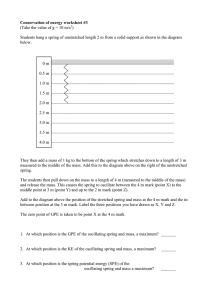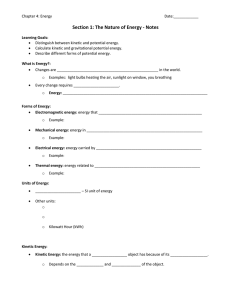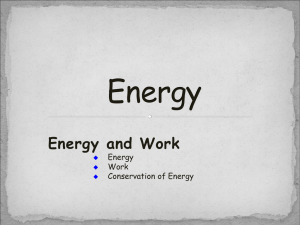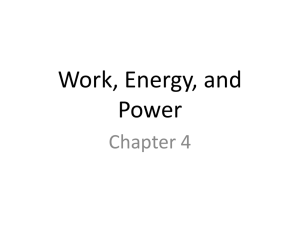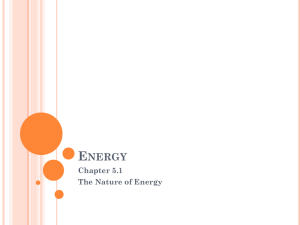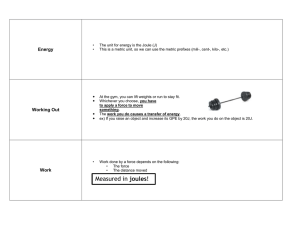CHAPTER 4: ENERGY
advertisement
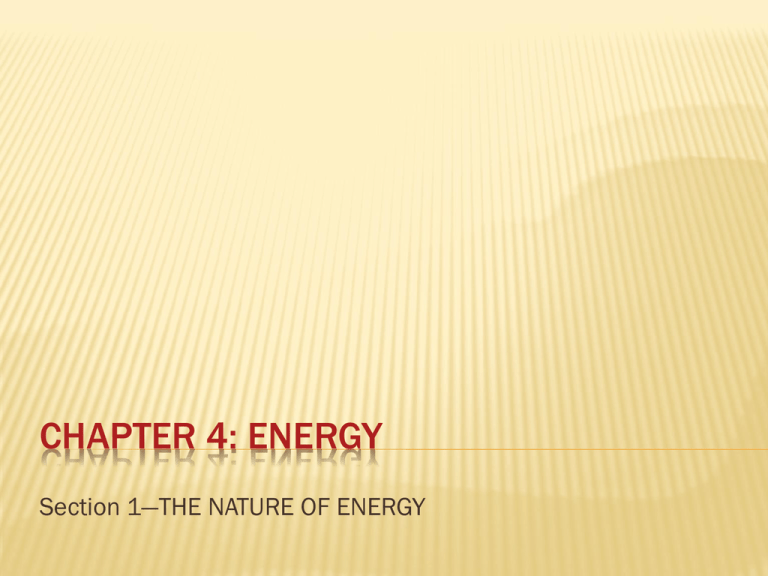
CHAPTER 4: ENERGY Section 1—THE NATURE OF ENERGY WHAT IS ENERGY? ENERGY is the ability to cause change. When something is able to change its environment or itself, it has energy. WHAT IS ENERGY? EXAMPLES—a moving baseball, a person walking, the wind blowing There are different forms of energy, such as electrical, chemical, and thermal. ELECTRICAL ENERGY— toaster CHEMICAL ENERGY—food, gasoline THERMAL ENERGY—Sun AN ENERGY ANALOGY… ENERGY VS. MONEY Money comes in many different forms: Cash in your wallet A bank account—check book Traveler’s checks Gold or silver coins Regardless of its form, money is money. THE SAME IS TRUE FOR ENERGY. Energy from the Sun that warms you and energy from the food you eat are only different forms of the same thing. KINETIC ENERGY KINETIC ENERGY is energy in the form of motion. The amount of kinetic energy depends on 2 quantities— the mass of the moving object and its velocity. ↑ mass = ↑ KE ↑ velocity = ↑ KE Kinetic energy = ½ mass x velocity2 KE (J) = ½ m (kg) x v2 (m2/s2) The JOULE is the SI unit of energy. POTENTIAL ENERGY Energy does not have to have motion. Even motionless objects have energy. This energy is stored in the object. Therefore, the object has potential to cause change. Stored energy due to position is called POTENTIAL ENERGY. EXAMPLES—An apple hanging in a tree has potential energy (stored energy due to position). If it falls…PE is converted to KE. THREE TYPES OF POTENTIAL ENERGY ELASTIC POTENTIAL ENERGY—is energy stored by something that can stretch or compress, such as a rubber band or spring (slinky). CHEMICAL POTENTIAL ENERGY—is energy stored in chemical bonds, such as food or gasoline. GRAVITATIONAL POTENTIAL ENERGY Anything that can fall has stored energy called gravitational potential energy (GPE). (Gravity caused the apple to fall from the tree.) The amount of GPE depends on 3 things: 1. the mass of the object 2. the acceleration due to gravity 3. the height above the ground GPE (CONTINUED) MASS is measured in kilograms. ACCELERATION of gravity on Earth is 9.8 m/s2. HEIGHT is measured in meters. GPE = mass x 9.8 m/s2 x height GPE(J) = m (kg) x 9.8 m/s2 x h (m) ***All energy, no matter which form it is in, can be measured in joules. GRAVITATIONAL POTENTIAL ENERGY (GPE) KINETIC VS. POTENTIAL CHAPTER 4: ENERGY Section 2—Conservation of Energy ENERGY IS MOST NOTICEABLE AS IT ____________ FROM ONE TYPE TO ANOTHER. Hair Dryer = Electrical Energy Thermal Energy Kinetic Energy Sound Energy SOME ENERGY TRANSFORMATIONS ARE NOT AS OBVIOUS… Ex. Green plants = Light energy Chemical potential energy MECHANICAL ENERGY MECHANICAL ENERGY is the total amount of Potential and Kenetic energy in a system and can be expressed by the following equation: ME= PE + KE ***MECHANICAL ENERGY IS DUE TO THE ___________AND ___________ OF THE OBJECT. Ex. An apple falling from a tree… Gravitational Potential Energy (GPE) is converted to Kenetic energy (KE), but the total Mechanical energy (ME) remains constant. THE LAW OF CONSERVATION OF ENERGY Energy can change from one form to another but the total amount of energy never changes. Another way to say this is that energy is conserved. The law of conservation of energy states that energy cannot be created or destroyed ***The total amount of energy in the universe remains constant. POWER PLANT NUCLEAR POWER PLANT GEOTHERMAL POWER PLANT HYDROELECTRIC POWER PLANT
